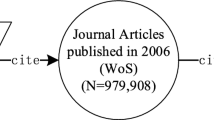Abstract
Highly cited articles are interesting because of the potential association between high citation counts and high quality research. This study investigates the 82 most highly cited Information Science and Library Science’ (IS&LS) articles (the top 0.1%) in the Web of Science from the perspectives of disciplinarity, annual citation patterns, and first author citation profiles. First, the relative frequency of these 82 articles was much lower for articles solely in IS&LS than for those in IS&LS and at least one other subject, suggesting that that the promotion of interdisciplinary research in IS&LS may be conducive to improving research quality. Second, two thirds of the first authors had an h-index in IS&LS of less than eight, show that much significant research is produced by researchers without a high overall IS&LS research productivity. Third, there is a moderate correlation (0.46) between citation ranking and the number of years between peak year and year of publication. This indicates that high quality ideas and methods in IS&LS often are deployed many years after being published.
Similar content being viewed by others
References
Adams, J. (2005), Early citation counts correlate with accumulated impact. Scientometrics, 63(3): 567–581.
Aksnes, D. W. (2003), Characteristics of highly cited papers. Research Evaluation, 12(3): 159–170.
Aversa, E. S. (1985), Citation patterns of highly cited papers and their relationship to literature aging — a study of the working literature. Scientometrics, 7(3–6): 383–389.
Batista, P. D., Campiteli, M. G., Kinouchi, O. (2006), Is it possible to compare researchers with different scientific interests? Scientometrics, 68(1): 179–189.
Bornmann, L., Daniel, H.-D. (2007), What do we know about the h index? Journal of the American Society for Information Science and Technology, 58(9): 1381–1385.
Braun, T., Glänzel, W., Schubert, A. (2006), A Hirsch-type index for journals. Scientometrics, 69(1): 169–173.
Burrell, Q. L. (2005), Are “sleeping beauties” to be expected? Scientometrics, 65(3): 381–389.
Cano, V., Lind, N. C. (1991), Citation life-cycles of 10 citation-classics. Scientometrics, 22(2): 297–312.
Carlin, A. (2003), Some bibliographic practices in interdisciplinary work: Accounting for citations in library and information sciences. Accountability in Research: Policies & Quality Assurance, 10(1): 27–45.
Cronin, B., Meho, L. (2007), Timelines of creativity: A study of intellectual innovators in information science. Journal of the American Society for Information Science and Technology, 58(13): 1–12.
Cronin, B., Meho, L. (2006), Using the h-index to rank influential information scientists. Journal of the American Society for Information Science and Technology, 57(9): 1275–1278.
Garfield, E (1975), The ‘obliteration phenomenon’ in science — and the advantage of being obliterated! Current Contents, (51/52): 5–7.
Garfield, E. (1980), Premature discovery or delayed recognition — Why? Current Contents, (26): 5–10.
Garfield, E. (1985a), The articles most cited in the SCI from 1961 to 1982. 7. Another 100 citation-classics — the Watson-Crick double helix has its turn. Current Contents, (20): 3–12.
Garfield, E. (1985b), The articles most cited in the SCI from 1961 to 1982. 8. Ninety-eight more classic papers from unimolecular reaction velocities to natural opiates — the changing frontiers of science. Current Contents, (33): 3–11.
Garfield, E. (1993), From obliteration to immortality. Current Contents, (45): 391–392.
Glänzel, W., Garfield, E. (2005), The myth of delayed recognition. The Scientist, 18(11): 8.
Glänzel, W., Schlemmer, B., Thijs, B. (2003), Better late than never? On the chance to become highly cited only beyond the standard bibliometric time horizon. Scientometrics, 58(3): 571–586.
Hirsch, J. E. (2005), An index to quantify an individual’s scientific research output. Proceedings of the National Academy of Sciences of the United States of America, 102(46): 16569-16572.
Levitt, J. M., Thelwall, M. (2007), A typical citation patterns in the twenty most highly cited documents in Library and Information Science. Proceedings International Conference of the International Society for Scientometrics and Informetrics: 11th, Madrid (Spain).
Merton, R. K. (1968), On the Shoulders of Giants: A Shandean Postscript. New York: Harcourt Brace & World.
Meyer, T., Spencer, J. (1996), A citation analysis study of library science: Who cites librarians? College and Research Libraries, 57(1): 23–33.
Oppenheim, C. (2007), Using the h-index to rank influential British researchers in information science and librarianship. Journal of the American Society for Information Science and Technology, 58(2): 297–301.
Porter, A. L., Cohen, A. S., Roessner, J. D., Perreault, M. (2007) Measuring researcher interdisciplinarity. Scientometrics, 72(1): 117–147.
Rice, R. E., CRAWFORD, G. A. (1992), Analysis of citations between communication and library and information science articles. Proceedings of the 55th Annual Meeting of the American Society for Information Science, 1992, pp. 8–12.
Tang, R. (2004a), Evolution of the interdisciplinary characteristics of information and library science. ASIST 2004: Proceedings of the 67th ASIST Annual Meeting, (1) 2004, pp. 54–63.
Tang, R. (2004b), Visualizing interdisciplinary citations to and from information and library science publications. Eighth International Conference on Information Visualisation, Proceedings, pp. 972–977.
Van Dalen, H. P., Henkens, K. (2005), Signals in science - On the importance of signaling in gaining attention in science. Scientometrics, 64(2): 209–233.
Van Raan, A. F. J. (2004), Sleeping beauties in science. Scientometrics, 59(3): 467–472.
Van Raan, A. F. J. (2006), Comparison of the Hirsch-index with standard bibliometric indicators and with peer judgment for 147 chemistry research groups. Scientometrics, 67(3): 491–502.
Zitt, M., Ramanana-Rahary, S., Bassecoulard, E. (2005), Relativity of citation performance and excellence measures: From cross-field to cross-scale effects of field-normalisation. Scientometrics, 63(2): 373–401.
Author information
Authors and Affiliations
Corresponding author
Rights and permissions
About this article
Cite this article
Levitt, J.M., Thelwall, M. The most highly cited Library and Information Science articles: Interdisciplinarity, first authors and citation patterns. Scientometrics 78, 45–67 (2009). https://doi.org/10.1007/s11192-007-1927-1
Received:
Published:
Issue Date:
DOI: https://doi.org/10.1007/s11192-007-1927-1




